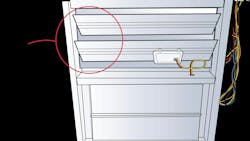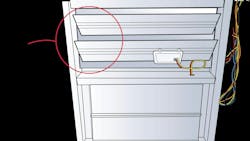How Return Duct Leaks Can Lead to High Indoor Humidity
Not too long ago, a friend of mine asked me for ideas about why the humidity was so high in a church they attend. He said it is common to have 70°F with 72% relative humidity (RH) inside the building. After some questioning, I found out the building has a 12.5-ton package unit with an economizer and return ducts in the crawlspace.
I told my friend to first check the fan setting on the thermostat. I also had him look for any openings in the return ducts and see if the economizer louvers were open. My friend’s next question is the reason for this article. He asked me, “Why do those things make a difference?” That’s a valid question and one you may have asked as well.
Let’s look at what happens when return air comes from damp places. The answer may help you find solutions if you struggle to keep humidity under control.
The Path of Least Resistance
Here’s one principle to help you understand what happens when humid air enters return ducts through unintended leaks: air takes the path of least resistance.
It’s easier for air to pull through a large duct leak (or multiple small leaks) near the air-handling equipment than from a return grille. Ideally, the same amount of air going into a return grille should also enter the fan inlet. There should not be another return air source unless it’s intentional.
Let’s say you have a four-ton cooling system with a fan moving 1600 cubic feet per minute (cfm) of air. You should also have 1600 cfm of conditioned air moving through the return grilles in a leak-free return duct system.
However, if the return ducts leak, air will follow the path of least resistance. In this scenario, air will bypass return grilles and instead pull through any duct leaks. The return air is now a mixture of living space air and moist air from leaks. Unfortunately, the closer leaks are to the air handling equipment, the greater the amount of moist air added.
The “Fan-On” Setting
Another issue that compounds return duct leakage is when the thermostat fan setting is in the “on” position. Many of your customers set their thermostats this way to better filter air moving through the HVAC system.
An economizer is a controlled return duct leak. It is also the closest opening to the fan inlet. Because of this, an economizer will pull more air than any leakage site, which can add to a humidity problem.
The fan on setting has been an area of controversy for decades. Since the air handling fan runs non-stop, any moisture left on the coil and drain pan dumps back into the airstream when the compressor is off. Once you add in return duct leaks, more humid air enters the system.
What About the Economizer?
Another component complicating my friend’s humidity issues is the economizer. Building codes often call for using economizers on most systems. Economizers are essential for ventilation in systems exceeding five tons.
Think about this: an economizer is a controlled return duct leak. It is also the closest opening to the fan inlet. Because of this, an economizer will pull more air than any leakage site, which can add to a humidity problem.
Economizer controller settings should manage economizer airflow. However, many economizer louvers don’t seal 100% airtight, so they are a prime location for humid air to enter the air handling system. Louver upgrades can provide better seals and reduce leakage.
Latent Capacity Suffers
Some HVAC equipment have limited moisture or latent removal capacity. Approximately 85% of the equipment’s total cooling capacity goes to lowering the space temperature. That leaves 15% to remove humidity from the air.
It doesn’t take long to overwhelm a system when you mix damp crawlspace air and 90°F outside air with a 72°F dew point. So, you’re left with a system that runs non-stop, leaving a building cold and clammy. Equipment performance will continue to suffer unless you deal with the extra moisture load at its source.
Next Steps
If you’re dealing with high humidity issues, start your investigation with the fan setting on the thermostat. Changing the fan switch position from on to auto may cause your problem to disappear. You can also inspect the return duct system. Look for something simple, like a disconnected return duct or multiple holes in the duct system.
If you’re dealing with high humidity issues, start your investigation with the fan setting on the thermostat. Changing the fan switch position from on to auto may cause your problem to disappear.
Often, you will need additional testing beyond what we cover in this article. One is to perform a building pressure test with a micromanometer. It’s a quick test that tells you much about the duct system. Turn the fan to its highest operating speed and watch what happens to pressures inside the living space. A positive pressure reading could reveal return duct leakage.
Sometimes, the results are inconclusive, and you need additional information that only diagnostic testing provides. Some options include measuring delivered airflow with a quality balancing hood or checking building infiltration with a blower door. Charge an additional fee for performance testing like this – don’t do it for free. Specialized test equipment and skills deserve a premium fee.
David Richardson serves the HVAC industry as Vice President of Training for the National Comfort Institute, Inc. (NCI). NCI specializes in training focusing on improving, measuring, and verifying HVAC and building performance.
If you’re an HVAC contractor or technician interested in learning more about diagnosing airflow issues, contact David at ncilink.com/ContactMe. NCI’s website, www.nationalcomfortinstitute.com, is full of free information to help you improve your professionalism and strengthen your company.
About the Author
David Richardson
Director, technical curriculum
David Richardson serves the HVAC industry as director of technical curriculum at National Comfort Institute, Inc. (NCI), Avon, Ohio. NCI specializes in training that focuses on improving, measuring, and verifying HVAC and Building Performance.

